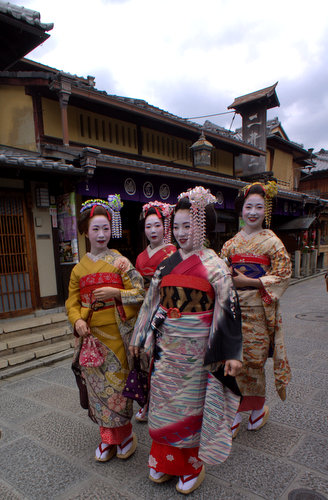Kyoto morning
While the narrow cobblestone streets in the Shimbashi district of Kyoto are a priority sight in every Japanese guide book, they can also be some of the most crowded places in the city – unless it’s early morning. The best time to visit is just as the neighborhood is waking up. As the day unfolds, the neighborhood fills with hundreds of camera-carrying tourists from around the world as well as young women playing Geisha dress-up. The company Maiko-Henshin offers a full Geisha costume experience for women and young girls that includes makeup, wig, kimono, ceremonial sandals and of course, an umbrella.
It must be fun to walk the ancient streets pretending to be a Geisha, but the cell phone toting girls are a far cry from the dedication and years of training required of the few Geisha that still reside in Kyoto. The dress-up Geisha, their photographers and tourists asking to take pictures with them, clog the area and make it harder to sense what it was once like to live there.
One strategy is to leave your hotel right after breakfast. Step into the Ryozen-Kwan-On temple with its imposingly serene 80 foot statue sitting against a backdrop of evergreens. Here, visitors are invited to touch several of the statues and make wishes – for a good match and a happy marriage or the lifting of misfortunes. To the left of the main temple sits the Negai-no-tama, a massive golden ball under a ceremonial roof. Drop a few yen in the box and place your right hand on the ball; then making a wish walk three times around the diameter to complete the ritual.
If you’re fortunate, a door will be unlocked at the back of the big statue. Here you can climb up a metal staircase into a shadowy room. There are more than ten small shrines, each dedicated to a birth year where you may light a candle for good luck.
By the time you leave the temple grounds, the old Gion center will be waking up. The streets will be groomed, swept and windows polished. Shop keepers will be rattling keys, lifting doors and watering gardens. Before the crowds arrive, you can stand, imagining what it was once like to be in that spot, on a narrow and ancient street that once bustled with wooden carts, kimono and robe clad merchants, shoppers, samurai warriors and aristocratic rulers.
Photo by the author, Elaine J. Masters
